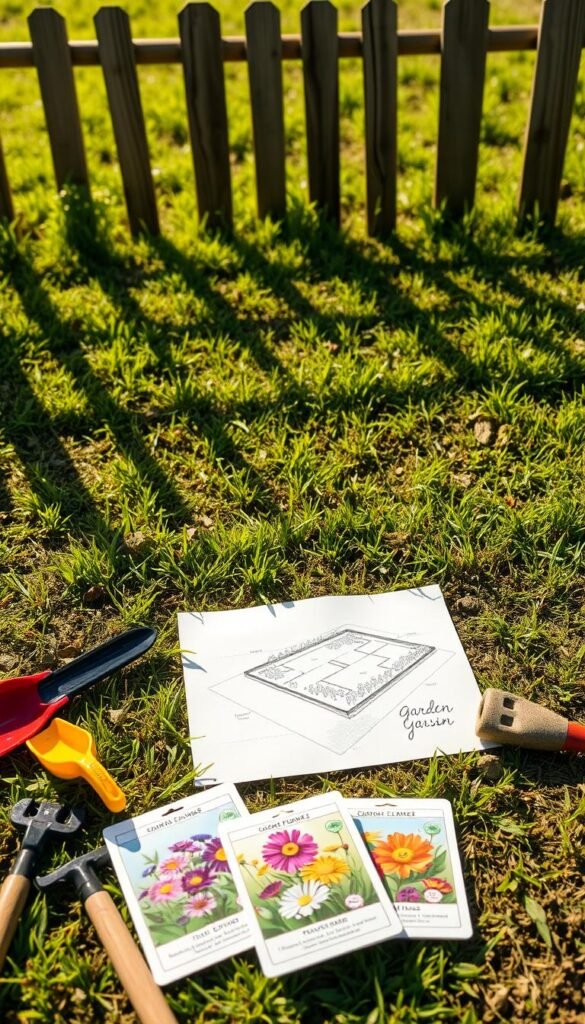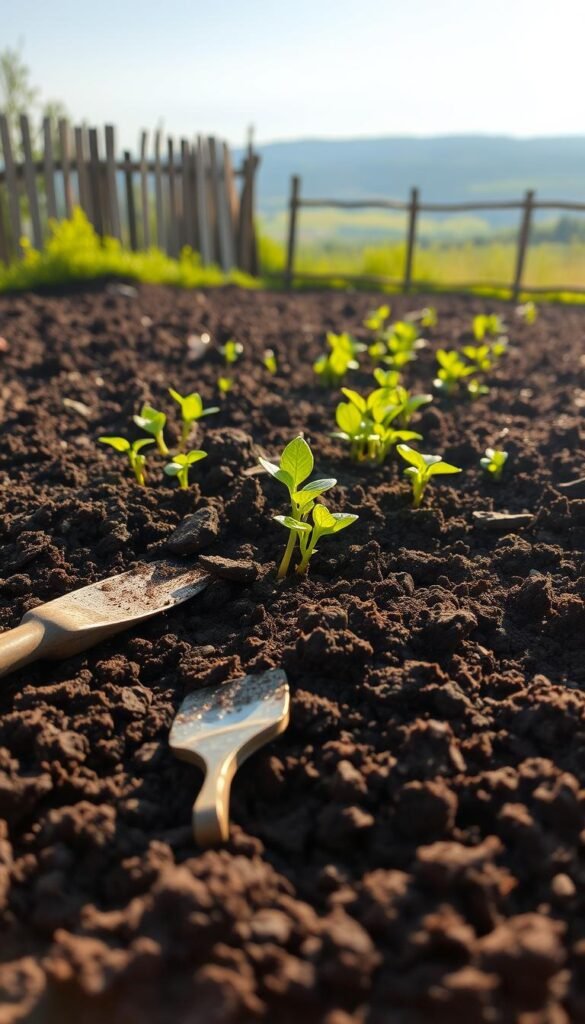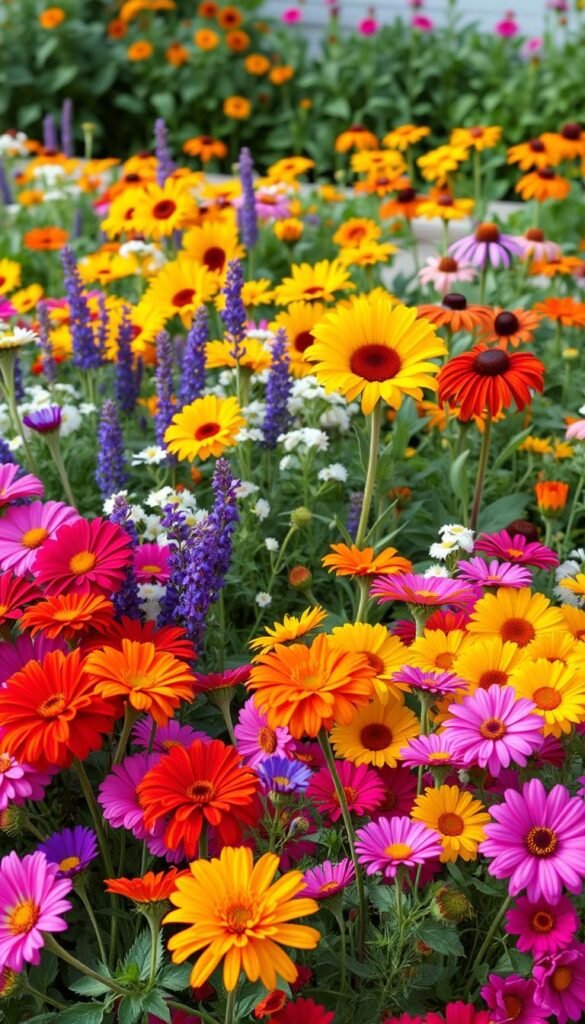Dreaming of vibrant blooms but worried about costs? You’re not alone. Many homeowners want to refresh their outdoor areas but feel limited by tight budgets. The good news? With thoughtful planning and a dash of creativity, you can turn even the plainest patch of dirt into a lively retreat.
Start by envisioning your ideal space. Do you crave cheerful zinnias lining a walkway or elegant roses framing your porch? Plants like purple bellflowers and orange canna lilies offer bold color at reasonable prices. Mixing perennials with seasonal annuals keeps your garden lively year-round without constant replanting.
Smart strategies make all the difference. Repurpose materials like stones or old containers, and focus on high-impact areas near entryways or seating spots. For more budget-friendly gardening tips, explore our guide to maximizing small spaces. Remember: a stunning flower garden isn’t about how much you spend—it’s about using resources wisely.
Your outdoor area is a blank slate waiting for personality. By prioritizing hardy plants and strategic layouts, you’ll create a welcoming yard that feels anything but ordinary. Ready to dig in?
Getting Started with Your Budget Garden Vision

Crafting a stunning outdoor retreat doesn’t require deep pockets—just smart planning. Begin by observing your yard like a detective. Walk through it morning, noon, and evening to map sunlight patterns. Does that corner stay shady all day? Which spots bake in afternoon heat? These clues determine what thrives where.
Next, explore plants native to your region. Local species like coneflowers or black-eyed Susans adapt better to your climate, saving water and maintenance time. As one gardener notes:
“Working with nature’s blueprint cuts costs and creates harmony.”
Think about your space beyond flowers. Will you need stepping stones between beds? A cozy bench under a tree? Sketch rough layouts using free apps or graph paper—even napkins work! Prioritize elements that serve multiple purposes, like decorative edging that also prevents soil erosion.
- Track sunlight zones (full sun/partial shade/full shade)
- Choose 3-4 core colors for visual cohesion
- Allocate 60% of your budget to plants and soil
Finally, set realistic expectations. Start small—transform one area first before expanding. Your garden should reflect your personality, not drain your wallet. With thoughtful design choices, you’ll create an outdoor space that grows more beautiful each season.
Planning Your Layout for Maximum Impact

Strategic design choices elevate even the simplest outdoor spaces. Start by dividing your garden into clear zones—like welcoming entry spots and cozy seating nooks. This creates depth and makes small areas feel larger while guiding visitors through your blooms.
Defining Your Garden Zones
Map out three key areas: high-visibility displays near windows, functional spaces for tools, and transitional pathways. Use existing materials like fallen branches or spare bricks to mark boundaries. Tall plants work wonders for hiding compost bins while adding vertical interest.
Creating a Focal Point with Flowers
Choose one showstopper per viewing angle—a cluster of bright sunflowers or a vintage ladder draped in morning glories. Place it slightly off-center using the rule of thirds. As one landscape designer suggests:
“Let your eye-catching element tell a story, whether it’s a burst of color or a nostalgic treasure.”
Curved pathways leading to your focal point create natural exploration. Pair low-growing marigolds with medium-height daisies near seating areas. This layered approach makes every space feel intentional without crowding your budget.
Soil Preparation and Fertilization Tips

Healthy plants begin with great dirt. Before you start planting, grab a $10 soil test kit from your local nursery. This quick check reveals your dirt’s pH and nutrient gaps—like getting a recipe before baking a cake.
Dig deep—literally. Use a shovel to loosen the top 8 inches of earth in your garden beds. Break up clumps and toss out rocks or stubborn weeds. This creates space for roots to stretch and water to flow freely.
Mix in homemade compost for a nutrient boost. Those banana peels and grass clippings? They’re gold for your soil. If you’re short on time, bulk compost costs less than bagged options. One gardener swears:
“Feed the soil, and the soil feeds your blooms.”
Apply fertilizer like salt—a little goes a long way. Choose slow-release granules that nourish plants gradually. Focus improvements on areas you’ll use this season, expanding next year as your budget allows.
Remember: Good prep today means fewer headaches tomorrow. Your garden will reward you with stronger roots and brighter flowers all season long.
Choosing Affordable Flower and Plant Varieties

Smart plant choices stretch your dollars while keeping color alive through every season. The secret? Combining showstoppers that bloom for months with sturdy evergreens that anchor your space when temperatures drop.
Seasonal Blooms and Evergreens
Plan for year-round drama by mixing quick-impact annuals with reliable perennials. Roses like Rosa ‘Flower Carpet Amber’ burst with color for eight months, while Rosa ‘Lady of Shalott’ paints your garden gold from June through October. Pair these with hardy geraniums or Erigeron karvinskianus for nonstop summer action.
Don’t forget winter warriors! Evergreen shrubs like boxwood or holly add structure when other plants sleep. As one thrifty gardener advises:
“A few evergreens are like winter’s welcoming committee—they keep your space feeling alive.”
Annuals vs. Perennials on a Budget
Perennials are your money-saving MVPs—they return yearly without replanting. Invest in 3-4 varieties first, then fill gaps with $1 seed packets or discounted annuals. Nurseries often slash prices by 50% in late summer!
- Swap divisions with neighbors for free plants
- Grow sunflowers or zinnias from seeds for instant joy
- Use annuals in pots for flexible color pops
By balancing upfront costs with long-term value, you’ll create a flower show that evolves beautifully year after year. Your wallet—and your garden—will thank you.
Designing Beautiful Raised Garden Beds
Elevate your gardening game without breaking the bank. Raised beds simplify plant care while adding structure to your outdoor space. These elevated planters improve drainage and let you skip back-breaking soil tilling.
Start small with untreated cedar or repurposed materials like concrete blocks. A 3-foot width lets you reach the center comfortably. One gardener shares:
“My first bed cost $15 using salvaged fence boards—it’s now bursting with peonies!”
Fill your garden bed with bulk soil mixes for better value. Position beds where they’ll get 6+ hours of sunlight. Add soaker hoses during setup to save watering time later.
These planters help control weeds and let you customize soil for different flowers. Try square-foot gardening in deeper beds to maximize blooms. Group several beds to create natural pathways that guide visitors through your floral displays.
Remember: raised beds work anywhere—patios, slopes, even rooftops. They turn challenging spaces into thriving flower zones while keeping maintenance manageable. Your back will thank you come harvest time!
Utilizing Vertical Space with Trellises and Planters

Short on ground space? Look up—your garden’s vertical potential is waiting to bloom. By growing upward, you turn unused walls and fences into vibrant displays. A simple trellis lets climbing roses or morning glories reach for the sky, while hanging planters add bursts of color at eye level.
Start with basic materials. Bamboo poles or wire mesh make sturdy supports for sweet peas. Repurpose old buckets or colanders as quirky containers—drill drainage holes and fill them with trailing petunias. One gardener laughs:
“My best planter? A retired pasta strainer!”
Attach lightweight pots to sunny walls using brackets. Try ferns in shaded areas or herbs near kitchen windows. For design inspiration, explore vertical flower gardening ideas that blend beauty with function. Tall, slim plants like alliums add height without crowding pathways.
Mix edible and ornamental choices. Pole beans on a lattice screen offer fresh snacks and greenery. Train ivy geraniums over arbors to create natural shade. These smart solutions turn blank surfaces into living art—all while keeping your budget rooted in reality.
Transforming a Bare Yard into a Beautiful Flower Garden on a Budget
Pathways can turn scattered flower beds into a cohesive landscape masterpiece. Begin by outlining walkways between your main planting zones using materials you already have. Fallen branches make charming temporary borders, while crushed gravel offers lasting structure at minimal cost.
| Material | Cost per Sq Ft | Installation Time | Maintenance |
|---|---|---|---|
| Mulch | $0.50-$2 | 15 minutes | Annual refresh |
| Stepping stones | $3-$8 | 2 hours | Weed occasionally |
| Crushed shells | $1.50-$4 | 30 minutes | Rake monthly |
Carve out intimate spaces within your yard by grouping fragrant roses with lavender near seating areas. A weathered bench surrounded by blooms becomes an instant retreat. As one homeowner shares:
“Our $20 flea-market table now hosts morning coffee amid hummingbirds and honeysuckle.”
Work in manageable sections—tackle one pathway per weekend. Photograph each completed zone to track progress. Connect distant beds by repeating flower colors or leaf textures along routes.
Keep interest year-round with this planting strategy:
| Season | Anchor Plants | Budget Fillers |
|---|---|---|
| Spring | Tulips | Pansies from seeds |
| Summer | Daylilies | Marigold seedlings |
| Fall | Mums | Ornamental kale |
Your garden gains rhythm when elements work together. Simple connections transform isolated patches into a unified oasis that delights at every turn.
Incorporating Creative Garden Beds and Pathways
Your outdoor space becomes a canvas when you blend imagination with practicality. Thoughtful arrangements of beds and walkways add structure while letting your personality shine. Let’s explore how to design features that work hard without costing a fortune.
Layered Flower Bed Ideas
Create depth by stacking plants like living staircases. Place tall sunflowers or hollyhocks at the back of your bed, medium-height daisies in the middle, and creeping thyme up front. This approach maximizes visibility and makes small beds feel lush. Use free materials like logs or cinder blocks to build tiers—they’ll hold soil and add rustic charm.
Unique Edging and Retaining Walls
Define spaces with unexpected borders. Press wine bottles neck-down along paths for a colorful wall that catches sunlight. Stack flat stones diagonally to create zigzag edges that guide the eye. These touches give your flowers a polished look while preventing soil runoff during storms.
Remember: creativity thrives within constraints. A mix of thrifted finds and natural elements can transform ordinary areas into conversation starters. Your garden’s story unfolds one thoughtful detail at a time.






